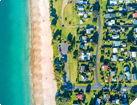- Home
- Site Analysis
- Site Use
- Passive Design
- Water
- Material Use
- Energy
- Wet Areas
- Health and Safety
- Other Resources
Site Analysis
Understanding all the features of a site, using and protecting the best, and minimising the impact of the worst.
Rising sea levels
A rise in sea levels as a result of climate change is a real hazard for existing and new buildings in coastal locations. Sea levels around New Zealand have risen by up to 220 mm in the last century but there is a broad consensus that much greater increases lie ahead.
A report from the UN’s Intergovernmental Panel on Climate Change (IPCC) released in mid 2021 provided updated estimates of future sea level rise. It forecast that under the best scenario (where greenhouse gas emissions fall relatively quickly) the global mean sea level will still rise by 0.3–0.5 m over the next 90 years. Under the worst scenario, where emissions continue with little change, a rise of up to 1 m in 90 years is forecast, with a 2 m rise not ruled out.
How different parts of New Zealand will be affected depends not just on sea-level rise, but also vertical land movement. Where parts of the country are slowly sinking, this will make the problem worse – there are some areas where the rate of sea-level rise will effectively double. Where parts of the country are being lifted up, this will offset part of the sea-level rise. The online maps developed by NZ SeaRise take account of both sea-level rise and vertical land movement.
According to the Stats NZ environmental indicator Coastal sea-level rise, relative annual sea levels around the country have risen faster in recent decades than when record keeping started. (The relative sea-level rise includes any local or regional changes in vertical land movement up or down.)
A joint report from the Ministry for the Environment and Stats NZ in October 2017 found that together with rising seas, “We can expect tides, waves, and storm surges (extremely long, slow waves) to reach further inland more regularly, resulting in more frequent and serious flooding…”
Erosion will be a growing problem in many areas, particularly on the east coast of both main islands.
For new house construction this will mean that some locations that could have been built on in the past may no longer be suitable because of:
- the threat of damage from flooding or erosion
- inability to get insurance
- local authority restrictions. (Under the Resource Management Act, local authorities are required to have particular regard to the effects of climate change.)
Insurance industry spokespeople have said that because rising sea levels cannot be considered as accidents or unforeseen events, resulting damage is not insurable.
Research published in 2020 found that some coastal homes in Wellington and Christchurch will find it difficult or impossible to get house insurance from 2030, with homes in similarly exposed locations in Auckland and Dunedin following only a few years later. In these four cities, at least 10,000 properties may be uninsurable by 2050.
Where construction is permitted, higher floor levels may be required by local authorities or greater setbacks, such as longer erosion hazard setbacks for cliff-top or beachside homes.
New restrictions may apply in existing settlements. Some district plans already identify Residential Closed Zones where further subdivision is prohibited, there can be no land filling, no new habitable buildings and no extension or replacement of existing habitable buildings closer to the shore.
For some existing settlements, choices will have to be made whether to restore natural defences to sea level rise (such as sand dunes or estuaries) or carry out (if possible) a managed retreat of existing buildings, giving up on land that is subject to high levels of flooding or erosion. All of the options have considerable costs. On one of the populated stretches of Hawkes Bay coastline, for example, the cost of work such as sea walls, groynes and managed retreat has been roughly estimated at $130–285 million.
A 2015 NIWA study estimated that there were 133,265 New Zealanders living less than 1.5 m above mean high water spring tide mark. It also estimated that within 3 m of this level there were nearly 294,000 land parcels, 166,750 buildings and a normally resident population of 281,902.
The hazard varies by location. Canterbury and Hawke’s Bay have the highest risk exposure, but the challenges are high in other locations too. In South Dunedin, for example, nearly 2,700 homes are less than 500 mm above the spring high-tide mark, with more than 70 percent of homes lying lower than 250 mm elevation. The council is examining how to deal with this, including the option of a “managed retreat”.
Another system for calculating land elevations came up with different estimates of the numbers of people at risk from rising sea levels. A study published in 2019 indicates that 15,000 New Zealanders live almost on the high tide mark, 71,000 within a metre and 240,000 within 2 metres of the mean high tide line.
Many councils are creating resources and tools to help with planning around flooding and sea level rise:
- Waikato Regional Council, for example, has created an online Coastal inundation tool that helps give a general indication of the areas that may be at risk.
- Greater Wellington Regional Council has also produced a website with a dynamic map of areas likely to be affected by sea level rise.
- Northland Regional Council has maps of areas at risk of coastal flooding and coastal erosion.
- Christchurch City launched its online map in 2021.
Research commissioned by councils is also finding evidence of sea level rise to support the forecasts of what is to come. Work done for Christchurch City Council looked at data collected between 2005–2020 in Lyttelton Harbour. It found a rise averaging 7 mm per year. This is substantially higher than earlier government data, which found a rise there of 1.3 mm/year from 1901–1960 and 2.7 mm/year from 1961–2017.
Rising sea levels put infrastructure at risk
A 2019 report by Local Government New Zealand (LGNZ) found that rising sea levels could put $2–14 billion of drinking water, wastewater and stormwater services, roading and other infrastructure at risk.
A rise of 0.5 metres could put roading, the three waters and building infrastructure valued at $2.7 billion at risk. The value rises to many times that figure for higher sea level rises.
These figures do not include the structures that sit on top of the infrastructure such as homes, schools, office buildings and factories.
A summary of the report can be found here and the full report here.
Updated: 20 October 2023


